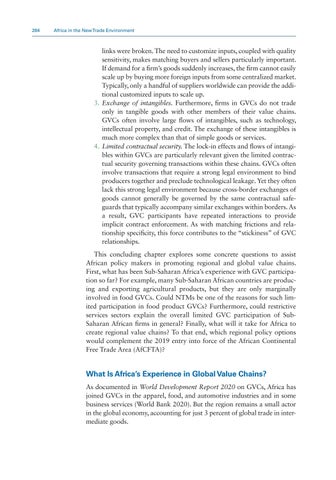284 Africa in the New Trade Environment
links were broken. The need to customize inputs, coupled with quality sensitivity, makes matching buyers and sellers particularly important. If demand for a firm’s goods suddenly increases, the firm cannot easily scale up by buying more foreign inputs from some centralized market. Typically, only a handful of suppliers worldwide can provide the additional customized inputs to scale up. 3. Exchange of intangibles. Furthermore, firms in GVCs do not trade only in tangible goods with other members of their value chains. GVCs often involve large flows of intangibles, such as technology, intellectual property, and credit. The exchange of these intangibles is much more complex than that of simple goods or services. 4. Limited contractual security. The lock-in effects and flows of intangibles within GVCs are particularly relevant given the limited contractual security governing transactions within these chains. GVCs often involve transactions that require a strong legal environment to bind producers together and preclude technological leakage. Yet they often lack this strong legal environment because cross-border exchanges of goods cannot generally be governed by the same contractual safeguards that typically accompany similar exchanges within borders. As a result, GVC participants have repeated interactions to provide implicit contract enforcement. As with matching frictions and relationship specificity, this force contributes to the “stickiness” of GVC relationships. This concluding chapter explores some concrete questions to assist African policy makers in promoting regional and global value chains. First, what has been Sub-Saharan Africa’s experience with GVC participation so far? For example, many Sub-Saharan African countries are producing and exporting agricultural products, but they are only marginally involved in food GVCs. Could NTMs be one of the reasons for such limited participation in food product GVCs? Furthermore, could restrictive services sectors explain the overall limited GVC participation of SubSaharan African firms in general? Finally, what will it take for Africa to create regional value chains? To that end, which regional policy options would complement the 2019 entry into force of the African Continental Free Trade Area (AfCFTA)?
What Is Africa’s Experience in Global Value Chains? As documented in World Development Report 2020 on GVCs, Africa has joined GVCs in the apparel, food, and automotive industries and in some business services (World Bank 2020). But the region remains a small actor in the global economy, accounting for just 3 percent of global trade in intermediate goods.


